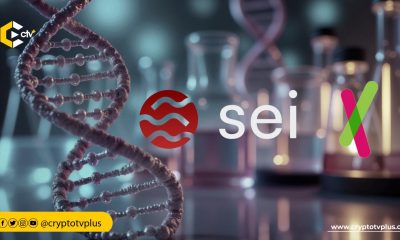Education
Understanding Liquid Staking Derivatives: A Solution to the Illiquidity Problem

One of the biggest trends in the blockchain industry today is the rise of staking, which allows users to earn rewards for holding and securing a cryptocurrency. Staking has become increasingly popular because it allows users to earn passive income on their holdings, while also contributing to the security of the network.
However, staking does come with some drawbacks. One of the main issues is the issue of illiquidity. Staked assets are usually locked up for a period, which means that users cannot access or trade their funds during that period. This can be a major inconvenience for investors who need to have liquidity for their assets. This can create a liquidity problem for token holders who need access to their funds for other purposes.
However, a solution to this problem has emerged in the form of liquid staking derivatives.
What are Liquid Staking Derivatives (LSDs)?
Liquid staking derivatives are a new financial instrument that enables users to earn staking rewards while also retaining liquidity over their staked tokens. In this model, a user deposits their tokens with a liquid staking provider, who then stakes those tokens on behalf of the user. In return, the provider issues the user a receipt or a token representing the staked tokens, which can be traded or used as collateral elsewhere.
A liquid staking token’s immediate liquidity comes at the expense of overall liquidity. The largest liquid staking token stETH trades less than $4m-$15m per day, while Ethereum’s native token ETH trades between $9b and $25b per day. That’s a lot of activity right there.
Liquid staking derivatives allow staked assets to be “unlocked” and traded as derivatives, such as futures or options, while still earning staking rewards. This means that investors can benefit from the rewards of staking, while also having access to liquidity for their assets.
Large market participants must carefully consider whether the size of their market is appropriate.
History of Liquid staking derivatives
Back on Dec 1, 2020, Ethereum tested the proof of stake (PoS) approach on its Beacon Chain. Through this approach, users could become validators by staking 32 ETH. Their ETH tokens, however, were subject to a locking period. This meant that the staked assets would be illiquid for a while.
The possibility of all these began enticing new staking users. But there was a serious problem. Not every investor had 32 ETH to spare for staking. And because staking was a viable option for earning passive income, users tried to find alternative ways to stake ETH without jeopardizing liquidity. As a result, the rise of ETH staking on the Beacon Chain has inadvertently led to the rise of liquid staking protocols.
Rocket Pool, for example, allows ETH holders to stake as little as 0.01 ETH in exchange for ERC-20-compliant liquid staking derivatives. These tokens are backed one-to-one, giving users the freedom to enter and exit the market whenever they want. Furthermore, because the tokens are derivatives, investors gain access to new markets. With a lower barrier to entry and greater liquidity flexibility, liquid staking protocols encourage more ETH holders to stake their tokens, thereby supporting the enhanced security and stability of the Ethereum network.
Fast forward to September 15, 2022, the Ethereum network successfully merged with its Beacon Chain, converting the entire Ethereum network from a proof of work (PoW) protocol to a proof of stake (PoS) protocol. Validators staking their ETH tokens completely replaced the miners who participated in the PoW protocol. While The Merge did not allow existing stakeholders to withdraw their locked tokens at the time of its launch, this will soon change with the Ethereum Shanghai upgrade.
Benefits of Liquid Staking Derivatives
The most obvious benefit of liquid staking derivatives is that they provide a solution to the illiquidity problem. With this model, users can earn staking rewards while still retaining access to their staked tokens. This can be particularly useful for those who need to use their tokens for other purposes or who want to have the flexibility to move their funds around as needed.
The size of the advantage depends on the blockchain and liquid staking token in question. Let’s use the Polkadot blockchain as an example. Stakers wishing to unstake, for example, are subject to a 28-day “unbonding period”. If a staker wants to react to a sudden market movement, they should sell a liquid staking token rather than wait to unstake.
Hence, they provide a way for investors to hedge their exposure to staking rewards.
Another example here is an investor who is staking Ethereum and might be concerned about the volatility of Ethereum’s price. By using liquid staking derivatives, the investor can hedge their exposure to Ethereum’s price, while still earning staking rewards.
According to Blockdaemon, $7.5B ETH is in liquid staking protocols. This accounts for 20% of the total share of ETH staked in ETH 2.0 contracts. As a result, the cryptocurrency markets gain liquidity and flexibility, as well as growth.
Another benefit of liquid staking derivatives is that they can provide a more efficient way for users to participate in staking. Instead of having to individually stake their tokens and manage their own nodes, users can deposit their tokens with a provider who will handle the staking process on their behalf. This can save users time and effort, while also reducing the barriers to entry for staking participation.
Risks of Liquid Staking Derivatives
While liquid staking derivatives offer many benefits, there are also some risks that users should be aware of. One potential risk is that the liquid staking provider may not be able to honour their obligations to the user. For example, if the provider experiences technical difficulties or suffers losses from the staking process, they may not be able to redeem the user’s receipt for the staked tokens.
Another risk is that the value of the liquid staking derivative may be subject to market fluctuations. While the derivative is designed to track the value of the staked tokens, its price may not always reflect the true underlying value of those tokens. This can create volatility and uncertainty for users who are holding the derivative.
Best Liquid Staking Protocols
There are numerous liquid staking solutions on the market, each with its own set of pros and cons. Furthermore, their fees may differ. So, what are some of the best liquid staking protocols?
Conclusion
Liquid staking derivatives offer a promising solution to the illiquidity problem facing many staking protocols in the blockchain ecosystem. By enabling users to earn staking rewards while retaining liquidity over their staked tokens, this model provides a more flexible and efficient way for users to participate in staking. However, users should be aware of the risks involved and should carefully consider their options before depositing their tokens with a liquid staking provider.
As the DeFi ecosystem continues to grow, we can expect to see more innovative solutions like liquid staking derivatives emerge, providing investors with new ways to earn income and manage risk in the cryptocurrency market.

























Pingback: Understanding Liquid Staking Derivatives: A Solution to the Illiquidity Problem by Kyrian Alex – CryptoTvplus Events: NFT, DeFi, Bitcoin, Ethereum, Altcoin Events